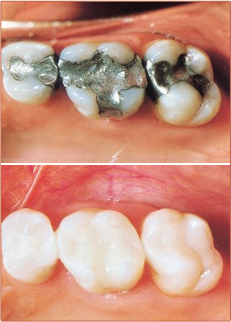


 Porcelain Veneers
Porcelain Veneers Teeth Whitening
Teeth Whitening Bonding
Bonding Tooth Colored Fillings
Tooth Colored Fillings Orthodontics
Orthodontics Gum Contouring
Gum Contouring Fillings
Fillings  On lays and Inlays
On lays and Inlays Crowns and Bridges
Crowns and Bridges Denture
Denture Extractions and Bone Grafts
Extractions and Bone Grafts Dental Implants
Dental Implants Periodic Checkups
Periodic Checkups Scaling and Root Planing
Scaling and Root Planing  Custom Night and Sports Guards
Custom Night and Sports Guards Snoring and Sleep Apnea
Snoring and Sleep Apnea Root Canal Treatment
Root Canal Treatment  Sealants
Sealants  Routine Checkup
Routine Checkup Fluoride Application
Fluoride Application Extractions
Extractions Space Maintainers
Space Maintainers Porcelain Fused Metallic Crown
Porcelain Fused Metallic Crown Dental Counseling
Dental Counseling Smile Makeover
Smile Makeover Neuromuscular Dentistry
Neuromuscular Dentistry Sedation Dentistry
Sedation Dentistry Laser Dentistry
Laser Dentistry Digital Dentistry
Digital Dentistry Relaxation Dentistry
Relaxation DentistryThe earlier your dentist spots your tooth decay, the better. It means that the decay is easier to clear away, the cavity smaller and therefore easier to fill. But what happens when the decay is not spotted earlier? What happens when the tooth has already decayed considerably so that a filling will not be sufficient?
In immediate answer is that, where a filling is insufficient, a crown is required. A crown is needed when the tooth has decayed to such an extent that the tooth itself is not strong enough to hold a filling. Therefore, your dentist clears away the decay, shapes the remaining parts of the tooth and then the crown is quite literally placed over the top.
Therefore, in terms of procedures, it is quite a leap from a filling to crown. A filling is quite often a relatively quick procedure that can be completed in just one visit. A crown is much more expensive to fit and requires at least two visits, as the mould needs to be taken then sent to a laboratory for the crown to be constructed.
So it is natural to look for a treatment which can sit neatly in between. Something stronger and more durable than a filling. Yet also something which is easier to fit than a crown and which allows you to salvage the remaining healthy parts of your existing tooth. This is exactly where onlays and inlays can be included in your dentist’s repertoire.
Onlays and inlays are deployed when the cavity is too large for a filling but the structure of the tooth is still sound. Therefore, rather than re-shaping a sound tooth to fit under a crown, your dentist can simply use an inlay or onlay. An inlay fills the gap in the tooth while the only is applied to the top of the tooth – but apart from positioning they essentially play the same function.
Usually, inlays and onlays are used to restore the back teeth as these are the teeth that do the most work, are the hardest to clean and often suffer the most from decay. Sometimes, they are also used to replace older amalgam fillings. The reason for this is because onlays and inlays can be manufactured from tooth-colored materials, such as composite resin or porcelain.
The treatment for onlays and inlays is usually a more straightforward process than fitting a crown. However, that does depend on the tooth and the amount of decay. An old amalgam filling may need to be removed, as well as the decay cleaned away. Then the onlay or inlay is prepared in a laboratory and usually fitted at a second appointment. Nowadays, some dental practices have the technology to create onlays and inlays on the same day, which means that they can sometimes be fitted during a single appointment.

